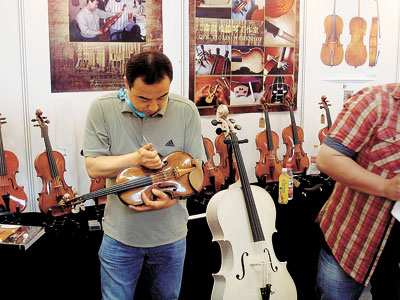
A QUICK survey of most entry-level music instruments being used by the Western world’s future pop stars would most likely reveal plenty of “Made in China” labels.
While the United States used to dominate the manufacturing of popular instruments such as guitars, pianos and violins, China has become the largest producer, currently holding 50 to 70 percent of the market, according to Zeng Zemin, general secretary of the China Musical Instrument Association.
Booming sales
The sales value of Chinese-made musical instruments is expected to exceed 30 billion yuan (US$4.9 billion) in 2014. Ten years ago, the figure was just more than 8 billion yuan, Zeng told Xinhua. The export value in 2014 was expected to reach 10.7 billion yuan, he said.
“Such significant growth lies in changes in the Chinese market. With the improvement of people’s lives, they spend more on cultural products and musical education than they have in the past,” Zeng said.
In addition to exports, many of the country’s musicians have migrated away from traditional Chinese instruments toward more internationally recognized instruments during the past two decades.
The Chinese have been inspired by young musicians such as pianist Li Yundi, who was the youngest pianist in 2000 to win the International Frederic Chopin Piano Competition.
Under such a drive, production and sales of both classical and traditional Chinese musical instruments have flourished.
Wu Tianyan, president of China’s leading musical company Parsons Music Corporation, said nearly 500,000 pianos are made every year worldwide, one-seventh of which are produced in Yichang, dubbed China’s piano city, in Hubei Province.
Having the world’s largest grand piano manufacturing base, Yichang produces 8,000 grand pianos and 8,000 high-end upright pianos, which are sold to more than 40 countries and regions.
High-end instruments
Working quietly in his studio, 48-year-old Qin Hongbai handmakes violins.
“Here we have no machines,” Qin said. “We only make high-end violins.”
Located in a residential building in western Beijing, Qin’s workshop is small but neat, with half-finished violins hanging on the wall.
With 32 years of violin-making experience and having won several international prizes, Qin’s violins have attracted buyers from Germany, the United States, New Zealand, Hong Kong and Taiwan, each selling for about US$10,000.
“I make only five to six violins a year because tone quality will always be the top element for a violin,” Qin said.
Even though more and more international professionals recognize China’s reputation as a musical instrument producer, China still only claims a small proportion of high-end musical instrument manufacturing and still has much to learn, Qin said.
Zeng said developed countries still monopolize the high-end instrument market — a violin can easily cost millions of yuan — as manufacturers in those countries possess eligible raw materials and advanced techniques.
“China still has a long way to go,” Zeng said.
Popular Chinese
instruments
Playing the traditional Chinese zhongruan for 12 years, French musician Djang San is adept at making various styles of music with the four-stringed plucked instrument.
“Ever since I started playing music, I have dreamed of exploring more music styles, and the zhongruan is the right instrument,” San said.
Wang Guozhen, head of the Shanghai No. 1 National Musical Instrument Factory, said overseas sales of traditional Chinese instruments in 2013 reached 20 million yuan while the figure was 1 million yuan in 1998.
Since 2007, the Ministry of Finance and other ministries have encouraged Chinese enterprises to participate in international musical instrument competitions and to expand exports of cultural products and services. (Xinhua)
|

